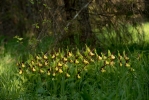Blog
Looking at this spring’s Cypripediums through different lenses (08.06.2016)
Text and photos: Aivar Pihelgas
This winter and spring were probably favourable to one of the most beautiful orchids of our forests – Cypripedium. The places that I am used to visiting each year were able to surprise me this spring – I cannot remember seeing that many flowers for a long time. Usually, seeing one Cypripedium flower has a wow effect. Can you imagine ending up on a meadow where there are hundreds of those. I counted the flowers of one Cypripedium clump and I got 167. But there were dozens of those clumps in that area. But the beauty does not rely on the number of flowers, especially on the photo. Most of the time, one beautifully captured flower is much more attractive than a lot of them together. But this time, I just couldn’t help but show you the beauty of the riches of these flowers.
I am often asked which macro lens I recommend for shooting flowers. There is no unique answer for that question. The choice of macro lenses is huge enough to find different and suitable lenses in different situations. The specificity of the macro lens is the possibility to focus from a short distance and have the subject as big as possible in the frame. When photographing small flowers, there is no other option. Most of the orchids that grow in Estonia have very small flowers and for bringing out the true beauty of the flowers, you need to get as close as possible. How about bigger flowers? Sometimes it is quite exciting to go into detail and capture the stamina from very close. The beauty of the flowers is often especially brought out when the surrounding environment is also captured on the photo. A flower growing in a natural environment often adds additional value to the photo as a natural and aesthetic background. In fact, I recommend trying out other lenses as well for photographing flowers. I often use Nikkor 70-200mm f/2.8 lens. With this lens, I like the sharpness of the subject in focus and also the softness of the background not in focus. The main advantages of this lens are its option to choose the focal length and sustainable optical power. The closest focal length is 1.4 metres but it is not a problem with longer focal lengths. I am fascinated in the ability to bring out the beauty of the plants through the sharpness but there are still enough details in the background as well and although the background is not sharp, you get the idea of the surrounding environment.
If you would like to add even more environment to the beauty of the flowers, you should use lenses with shorter focal length. But you have to carefully follow the closest focusing area. The closest focusing area of Nikkor 14-24mm F/2.8 is 0.28m. And you also have to consider that the wider the angle you would like to photograph the bigger the image distortion, especially towards the edges of the frame. When shooting from further away, you get the growing place on the photo but the flowers are pictured small. But you can balance the situation by choosing the shooting distance and also the height and the results may still meet your needs.



